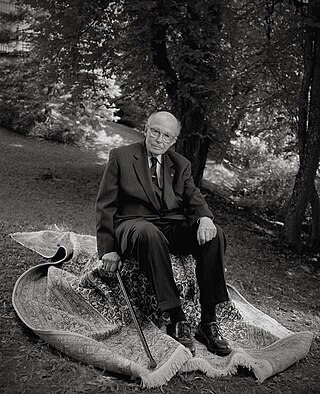
Otto von Habsburg was the last crown prince of Austria-Hungary from 1916 until the dissolution of the empire in November 1918. In 1922, he became the pretender to the former thrones, head of the House of Habsburg-Lorraine, and sovereign of the Order of the Golden Fleece upon the death of his father. He resigned as Sovereign of the Golden Fleece in 2000 and as head of the Imperial House in 2007.

Mürzzuschlag is a town in northeastern Styria, Austria, the capital of the former Mürzzuschlag District. It is located on the Mürz river near the Semmering Pass, the border with the state of Lower Austria, about 85 km (53 mi) southwest of Vienna. The population is 8,684. Originally an industrial area, the nearby mountains are today a popular ski resort.
The Austrian resistance launched in response to the rise of the fascists across Europe and, more specifically, to the Anschluss in 1938 and resulting occupation of Austria by Germany.

Gloggnitz is a mountain town in the Neunkirchen district of Lower Austria, Austria.
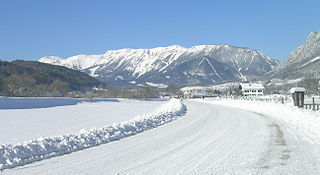
The Rax is a mountain range in the Northern Limestone Alps on the border of the Austrian federal provinces of Lower Austria and Styria. Its highest peak is the Heukuppe. The Rax, together with the nearby Schneeberg, are a traditional mountaineering and mountain walking area, and are called the Wiener Hausberge. They are separated by the deep Höllental.

Nathaniel Meyer von Rothschild was a member of the Rothschild banking family of Austria, known as art collector and patron.
Bezirk Neunkirchen is a district of the state of Lower Austria in Austria. It is located at the south of the state.

Heinrich Maier was an Austrian Roman Catholic priest, pedagogue, philosopher and a member of the Austrian resistance, who was executed as the last victim of Hitler's regime in Vienna.
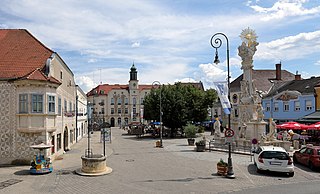
Neunkirchen is the capital of the district of Neunkirchen in the Austrian state of Lower Austria. As of 2020 it has a population of 12,721.
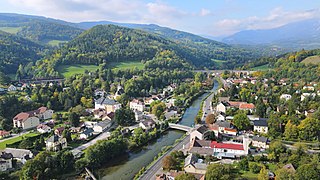
Payerbach is a town in the district of Neunkirchen in the Austrian state of Lower Austria.
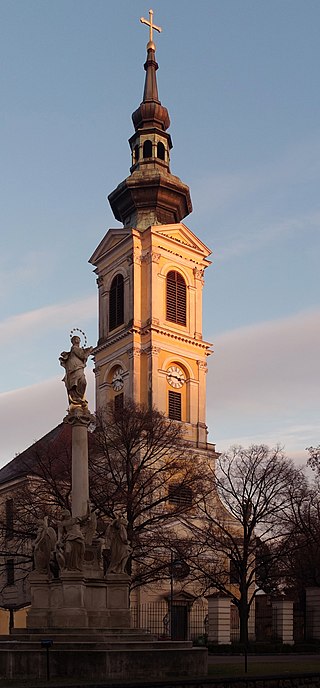
Großweikersdorf is a municipality in the district of Tulln in the Austrian state of Lower Austria.

The Lower Austrian Höllental Railway is a narrow gauge electric railway with a track gauge of 760 mm, which runs from the Austrian Federal Railways (ÖBB) station of Payerbach Reichenau on the Semmering Railway for approximately five kilometres through the market town of Reichenau an der Rax to Hirschwang.

The Southern Railway is a railway in Austria that runs from Vienna to Graz and the border with Slovenia at Spielfeld via Semmering and Bruck an der Mur. Along with the Spielfeld-Straß–Trieste railway, it forms part of the Austrian Southern Railway that connected Vienna with Trieste, the main seaport of the Austro-Hungarian Monarchy, via Ljubljana. A main obstacle in its construction was getting over the Semmering Pass over the Northern Limestone Alps. The twin-track, electrified section that runs through the current territory of Austria is owned and operated by Austrian Federal Railways (ÖBB) and is one of the major lines in the country.

The Rax-Schneeberg Group is a mountain range in the Northern Limestone Alps on the Styrian-Lower Austrian border in Austria.

The Schwarza is a river in Lower Austria. It is the left headstream of the Leitha.

The Höllental in Lower Austria is a narrow valley between the steep limestone massifs of the Schneeberg and Rax through which the River Schwarza flows.

The Villa Wartholz or Castle Wartholz is a former imperial villa in Reichenau an der Rax in Lower Austria.

Vienna's Hausberge are the mountains of Raxalpe, Schneeberg and Hohe Wand in the south of the state of Lower Austria. These mountains may be reached from Vienna in about an hour and are therefore a popular recreation area for the Viennese.
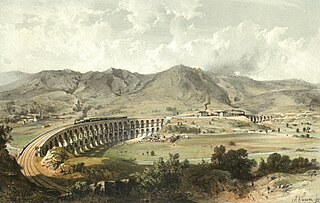
The Austrian Southern Railway is a 577.2-kilometre (358.7 mi) long double track railway, which linked the capital Vienna with Trieste, the former main seaport of Austria-Hungary, by railway for the first time. It now forms the Southern Railway in Austria and the Spielfeld-Straß–Trieste railway in Slovenia and Italy.

The Heimatstil is an architectural style of the second half of the nineteenth century and the first half of the twentieth referring to the historicist tendencies which one encounters in the German-speaking countries, including Switzerland, but also in Victorian England and even in the north and eastern parts of France, as well as Belgium and Flanders. The Heimatstil is characterized by the use of wood on the façade and sculpted beams, connected by protruding or rusticated stone, recalling the illustrations from literature and folklore, especially Germanic ones, from the time period.



































